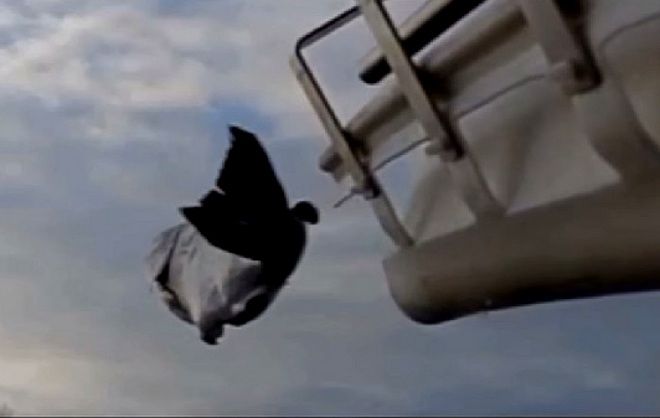forum
library
tutorial
contact

Whooshh: No Dam Problem
with the Salmon Cannon
by Manon Verchot
Treehugger, August 22, 2014
|
the film forum library tutorial contact |

|
Whooshh: No Dam Problem
by Manon Verchot
|
 Admit it, it's funny. A salmon gets sucked up into a tube, propelled through at 22 miles an hour and comes flying out the other end, tail flapping in the wind.
Admit it, it's funny. A salmon gets sucked up into a tube, propelled through at 22 miles an hour and comes flying out the other end, tail flapping in the wind.
This is the invention of Whooshh Innovations, a fruit and fish transport company based in Washington. And hilarity aside, it serves an important purpose: salmon conservation and restoration.
The idea came to the company several years ago, when salmon population decline was all over the news. Dams like the Grand Coulee Dam, 551 feet high, blocked - and continue to block - salmon passage back to their spawning grounds. Salmon imprint on the spawning ground they hatched in, but unable to get up stream, many were forced to lay their eggs in warmer or more turbulent waters, or did not reproduce at all. In the last two decades, salmon populations declined by an estimated 50 percent.
"In the Columbia Basin, the science and research we have regarding climate change and climate effects on salmon, suggests that we desperately need to find ways to let salmon access some of the better habitats in the Columbia basin - that is, the cooler water, the welcoming headwaters," Charles Hudson, intergovernmental affairs director for the Columbia River Inter-Tribal Fish Commission, told TreeHugger.
Whooshh already had technology to delicately transport fruit. Their apple transporting tubes allowed apple pickers to stay on top of the ladder and feed apples into the tubes instead of having to go back and forth carrying buckets. The apples came out the other end with no bruising. So one day, a Whoosh employee put a tilapia fish into the tubes and watched it fly - and the idea for the fish transporter was born.
Since then, fish aren't the only things that have passed through the transporters - the team has played with Christmas ornaments, chickens (dead, of course) and watermelons.
"It's been fun," Todd Deligan, vice-president of fish transport at Whooshh, told us. "But at the same time, we always want to remind people that we're dealing with very serious issues and we need to focus on those issues."
So far, the salmon cannon seems to be working. In trials at the Roza Dam in Washington, fish have been attracted to the transporter and swim towards it willingly. The system has carried salmon over 100 vertical feet, and could go higher. It can also transport 40 fish per minute.
Ultimately, the salmon cannon is a more cost effective and efficient method for getting fish over dams than methods like fish stairs - a structure around a dam that fish jump up. In some cases conservationists even truck - and occasionally helicopter - salmon over dams.
But dams are not the only things causing problems for salmon population. Cattle walking into streams can kill eggs and over fishing is a constant problem. Organizations like the Columbia River Inter-Tribal Fish Commission have been working for years to encourage multiple approaches to restoring populations.
Hudson told us, "Salmon is linked to life itself. Without water, without fish, we are not people."
Many northwestern tribes rely on salmon as a form of primary subsistence. Salmon, when abundant, has also been a source of income for people in the region.
"The best intervention man can make is in the egg to smolt [juvenile] stage," added Hudson. Increasing egg to smolt survival will have drastic effects on salmon populations. For Hudson, the salmon transporting conduit is just one of the ways to encourage salmon survival.
The salmon cannon also has some interesting implications for hydropower. A major obstacle to increasing hydropower in the United States has been the effect it would have on fish populations. With the fish transportation conduit, fish populations might be able to get around hydro-electric plants without being killed by the turbine blades.
While these projects are in the pipeline, Whooshh and the Department of Energy will be running more tests on the salmon transporter from now through September, seeing how they can improve the system and contemplating its use at hydroelectric dams.
Vice president Deligan said we'll be able to see the big picture better in two or three months "The bigger picture is what's important here - not just the funny salmon cannon."
Related Sites:
Last Week Tonight with John Oliver: Salmon Cannon HBO, 11/9/14
learn more on topics covered in the film
see the video
read the script
learn the songs
discussion forum
